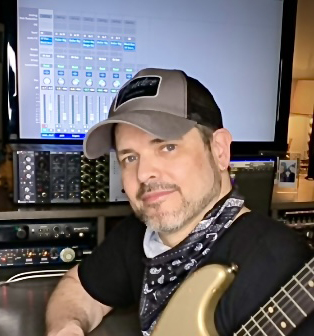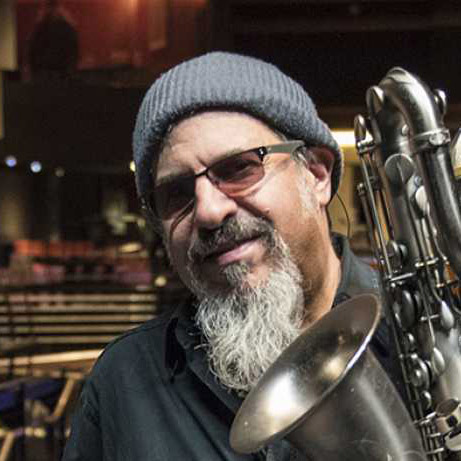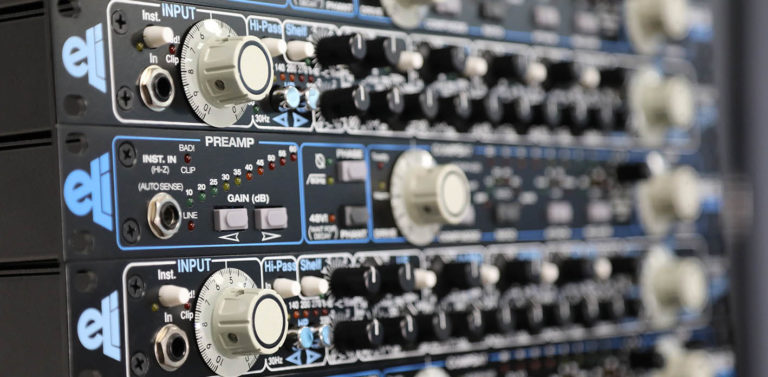
Modern Digitally Controlled Microphone Preamp
In today’s modern age of digital recorders, DAWs and software plug-ins, Mike-E is the ultimate solution for getting a clean and strong, yet warm and musical signal into the box…and it couldn’t be easier to work – its front panel layout is so straight ahead that even inexperienced engineers will have no problem moving around on it right away.
When the engineering team at Empirical Labs sets out to build a microphone preamp, you can be sure it’ll deliver spectacular sound, be effortless to work, and will provide features unlike any other device in its class. To that end, we proudly present Mike-E, a high performance transformer-coupled mic preamp with a noise floor far below any microphone’s self noise, combined with a one-of-a-kind compressor/saturator circuit that delivers classic knee compression as well as versatile tonal ‘coloring’ that can replicate many of the best characteristics of vintage analog recording equipment.

Mic Preamp
The Mike-E features a super low noise transformer input amplifier section with the gain under precise digital control. The signal to noise far exceeds any microphone in existence. Having used many mic preamps over the years, we’ve implemented a unique stepped gain control that should be impervious to the normal flakiness that age causes to pots and detented switches. A “Bad!” LED indicates when the input signal is overloading the circuit.

CompSat™
The CompSat’s unique circuitry sets the Mike-E apart from all other mic preamps.
SATURATOR – a multi stage soft-clipping circuit. At lower levels, a triode-type saturation affects the signal. As the level increases, a second unique clip circuit starts to more severely flatten out the peaks.
COMPRESSOR – based on ELI’s world famous Distressor, but with other characteristics (including a much longer attack time). Preset ratios include: 2:1, 4:1, 8:1…and, of course, Nuke.
EMPHASIS – a two-stage circuit that boosts and soft clips high frequencies before the CompSat™ circuit, and then cuts the frequencies after it. Emphasis has the added perk of improving signal to noise, and is the reason analog tape decks used emphasis to begin with.


The Mike-E's Seven Circuits
Mic Preamplifier
Direct Box
Colored HP Filter
Phase Switch
CompSat
Emphasis
Mix Control
Specifications
- Frequency Response – 3 Hz to 200 kHz on (No CompSat). CompSat is 3Hz – 150Khz. Optional Transformer output is 6Hz–80kHz.
- Signal to Noise – 130 dB signal to Noise.at 40dB gain. Maximum output is +28dBu.
- Distortion – Ranges between .0006% and 15% depending on mode and settings.
- I/O – Transformer coupled Input, Active and Transformer Outputs available. High quality audio caps used internally.
- Impedance – Input Impedance is above 600 Ohms at all frequencies, transformer coupled. Output impedance is less than 38 ohms. Instrument In Impedance is 332K Ohms.
- Attack/Decay Ranges – .9 – 100mS Attack; .05 – .5 Sec. Release
- Power Consumption – 15 Watts Max.
- Metal Chassis – single height 1.75″ high, 10″ deep, 19″ wide.
- Shipping info – Box dimensions 22.5″ x 18.5″ x 3 1/4″.
Software Version

Precisely modeled in collaboration with Dave Derr himself, Softube’s native software version of the Mike-E tethers unabashed analog flavor to an uncomplicated, modern interface. Mike-E makes it fun to push it past the extremes without brittleness. Do anything from giving credibility to vocals in a mix with soft-knee compression and warm saturation to smashing drum room mics with the famous NUKE mode.

Options/Upgrades
Output Transformer
METranOutMod
All upgrades include a 24-hour burn in, full QC and unit test for the latest specifications, and free shipping back within the continental United States.
FAQs
Can I use 2 Mike-E’s as a buss compressor?
Yes, you can! You will probably put the Mic Gain on Line (0dB Gain). Generally you would use a low ratio (2:1), with the slowest attack (100mS) on such a mixdown compressor. However, the MIX control offers a whole other approach to Stereo Buss compression. More on that later. For now lets assume the MIX control is full CW (10) and you are hearing only the compressor output. For the loudest MIX, keep the release fast also (.05S). With the Slow attack and fast release, the transients will come through without over compression, and the fast release will keep the music from pumping after an attack. 1 – 3 dB is usually enough gain reduction.
Can the CompSat section emulate analog tape?
Put the CompSat on 1:1, and adjust drive so the warm light is on often, and the Toasty LED lights on peaks. Set the Mix Control to full CW (10) and the user will gain a dB or two of “heat” and headroom. The Mike-E will be flattening the peaks out gently with its saturation circuit. Engaging the Emphasis will make the high frequencies clip earlier and soften peaky and possibly harsh “build-ups”. It has the added benefit of decreasing noise. Emphasis was used in all modern tape recorders to improve Signal to Noise and dynamic range. Going to another compressor after this will give you a familiar tape like vocal sound. Compressors react differently after a signal has been soft clipped, or on tape.
How do I get the best level on the Mike-E?
THE PREAMP GAIN IS THE MOST CRUCIAL CONTROL TO SET PROPERLY ON THE MIKE-E! Set initial levels by using the following CLIP- TEST. Turn CompSat Drive to 0 and Output to 5 so those sections don’t clip. Have the source produce a loud “peak” sound repeatedly, and adjust input mic gain till BAD! LED just lights. Then adjust mic gain down one (sometimes two) 5dB step(s) from this CLIP TEST to allow headroom. The Mike-E has a huge “sweet” spot. Most mics operate well at 30 to 40dB of gain for voice level sources. If not using the CompSat, you can set output level to 7 or 8 for initial level.
Using the CompSat circuit is a world unto itself, offering some unique processing for the otherwise pristine Mic Preamplifier. Enable the CompSat by pressing the Ratio taking it “out” of Bypass to 1:1 or an actual compression ratio. With so many options, lets make it simple by using the CompSat as a soft knee compressor only. Set the MIX control to full CW COMPRESS (10 on MIX knob), and set the compressor to 4:1 attack 8mS, release .1S. Use the DRIVE control to adjust how much compression you want. Until you are really experienced, its best to be conservative at first when tracking, keeping the Gain Reduction below 13dB. Because of gain reduction, you may have to make up the gain on the output control. There is tons of headroom once the compressor is engaged, and running the output knob higher, or even all the way to 10 is perfectly fine, as long as no Clip indicator (BAD!) lights. If the CompSat is bypassed, it’s best to keep Drive at 0.
Can I link two Mike-E’s together?
The user should plug in a short 1⁄4” mono phone cable to both unit’s Link jacks, and match the controls on the two Mike-E’s for Stereo Buss use. Turn on the LINK setting on both units. Matching the front panel controls will yield highly accurate response between the two channels. You do not have to remove the cable to use them as two independent “mono” units. Footnote: If linking two Mike-E’s, gain reduction will differ if one has an attack of 100mS, and the other doesn’t.
Videos
Testimonials



Related Articles




